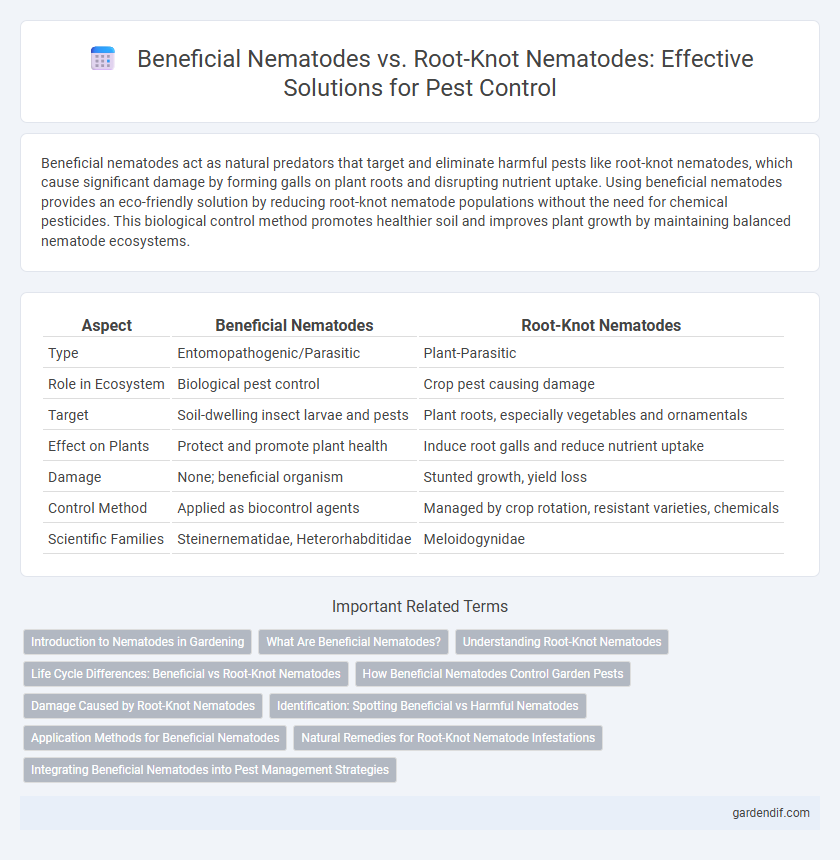
Beneficial nematodes vs Root-knot nematodes Illustration
Beneficial nematodes act as natural predators that target and eliminate harmful pests like root-knot nematodes, which cause significant damage by forming galls on plant roots and disrupting nutrient uptake. Using beneficial nematodes provides an eco-friendly solution by reducing root-knot nematode populations without the need for chemical pesticides. This biological control method promotes healthier soil and improves plant growth by maintaining balanced nematode ecosystems.
Table of Comparison
| Aspect | Beneficial Nematodes | Root-Knot Nematodes |
|---|---|---|
| Type | Entomopathogenic/Parasitic | Plant-Parasitic |
| Role in Ecosystem | Biological pest control | Crop pest causing damage |
| Target | Soil-dwelling insect larvae and pests | Plant roots, especially vegetables and ornamentals |
| Effect on Plants | Protect and promote plant health | Induce root galls and reduce nutrient uptake |
| Damage | None; beneficial organism | Stunted growth, yield loss |
| Control Method | Applied as biocontrol agents | Managed by crop rotation, resistant varieties, chemicals |
| Scientific Families | Steinernematidae, Heterorhabditidae | Meloidogynidae |
Introduction to Nematodes in Gardening
Beneficial nematodes are microscopic roundworms that naturally control harmful soil pests by parasitizing insect larvae, promoting healthier plant growth and reducing the need for chemical pesticides. Root-knot nematodes, a type of plant-parasitic nematode, infect plant roots causing galls that disrupt nutrient uptake and stunt development, leading to significant crop damage. Understanding the difference between these nematode types is crucial for effective pest management and sustainable gardening practices.
What Are Beneficial Nematodes?
Beneficial nematodes are microscopic, soil-dwelling organisms that naturally control pest populations by parasitizing harmful insects and root-knot nematodes. These biological control agents penetrate the larvae or eggs of root-knot nematodes, releasing symbiotic bacteria that kill the pests quickly and enhance soil health. Their use is a sustainable alternative to chemical pesticides in managing root-knot nematode infestations and promoting agricultural productivity.
Understanding Root-Knot Nematodes
Root-knot nematodes (Meloidogyne spp.) are microscopic soil pests that infect plant roots, causing characteristic galls and disrupting nutrient uptake. These nematodes penetrate root tissues, leading to stunted growth, yellowing leaves, and reduced crop yields. Effective management relies on accurate identification and understanding their life cycle to implement targeted biological controls such as beneficial nematodes (Steinernema spp. and Heterorhabditis spp.) that act as natural antagonists by parasitizing root-knot nematodes.
Life Cycle Differences: Beneficial vs Root-Knot Nematodes
Beneficial nematodes have a life cycle that involves infecting and killing soil-dwelling insect pests, directly targeting hosts and reproducing within them before emerging to seek new prey. Root-knot nematodes, conversely, penetrate plant roots, inducing gall formation and extracting nutrients while reproducing inside the root tissue, which disrupts plant growth. The contrasting life cycles highlight beneficial nematodes as natural biocontrol agents, while root-knot nematodes act as destructive plant parasites.
How Beneficial Nematodes Control Garden Pests
Beneficial nematodes effectively control garden pests by parasitizing and killing soil-dwelling insects such as root-knot nematode larvae, which cause damage to plant roots by forming galls. These microscopic roundworms enter pest larvae through natural body openings, releasing symbiotic bacteria that rapidly kill the host, reducing root damage and improving plant health. Using beneficial nematodes provides an eco-friendly pest control method that targets root-knot nematodes without harming beneficial soil organisms or the environment.
Damage Caused by Root-Knot Nematodes
Root-knot nematodes (Meloidogyne spp.) cause extensive damage by forming galls on plant roots, disrupting nutrient and water uptake that leads to stunted growth and reduced yields. These parasitic nematodes penetrate root tissues, triggering root knot formation that impairs root function and increases susceptibility to secondary infections. In contrast, beneficial nematodes (Steinernema and Heterorhabditis species) act as biological control agents by infecting and killing harmful soil pests without harming plant roots.
Identification: Spotting Beneficial vs Harmful Nematodes
Beneficial nematodes are microscopic roundworms used in pest control due to their ability to parasitize soil-dwelling insect pests, whereas root-knot nematodes are harmful plant parasites causing galls on roots and stunted growth. Identification relies on microscopic examination, as beneficial nematodes possess distinct morphology and behavior targeting insects, while root-knot nematodes induce visible root damage and have different anatomical features. Molecular diagnostic tools such as DNA sequencing enhance accuracy in distinguishing these nematodes to optimize pest management strategies.
Application Methods for Beneficial Nematodes
Beneficial nematodes are typically applied through soil drenching or incorporation into irrigation systems to target root-knot nematodes effectively. These entomopathogenic nematodes enter the soil environment and actively seek out root-knot nematode larvae, providing biological control without harmful chemicals. Proper application timing, such as during early soil infestation or before nematode population peaks, ensures maximum efficacy in suppressing root-knot nematodes.
Natural Remedies for Root-Knot Nematode Infestations
Beneficial nematodes, such as Steinernema and Heterorhabditis species, serve as effective natural predators against root-knot nematode infestations by parasitizing and killing these harmful pests. Root-knot nematodes (Meloidogyne spp.) cause significant damage to plant roots, leading to reduced crop yields and stunted growth, making biological control essential for sustainable agriculture. Using beneficial nematodes as a natural remedy helps suppress root-knot nematode populations without harmful chemicals, promoting soil health and long-term pest management.
Integrating Beneficial Nematodes into Pest Management Strategies
Integrating beneficial nematodes like Steinernema and Heterorhabditis species into pest management strategies offers an eco-friendly approach to controlling root-knot nematodes (Meloidogyne spp.), which cause significant crop damage by inducing gall formation on roots. Beneficial nematodes parasitize and kill root-knot nematode juveniles in the soil, effectively reducing pest populations without harmful chemical residues. This biological control method enhances soil health, supports sustainable agriculture, and complements other integrated pest management (IPM) practices for efficient nematode suppression.
Beneficial nematodes vs Root-knot nematodes Infographic

 gardendif.com
gardendif.com